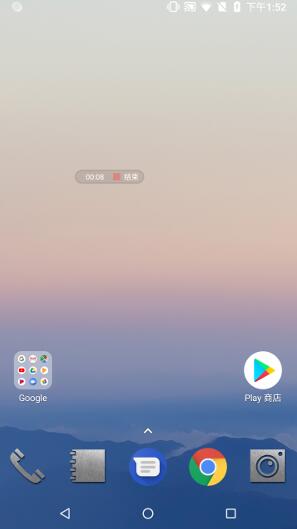android桌面懸浮窗顯示錄屏?xí)r間控制效果
本文實(shí)例為大家分享了android桌面懸浮窗,實(shí)現(xiàn)錄屏?xí)r間控制顯示效果的具體代碼,供大家參考,具體內(nèi)容如下
創(chuàng)新互聯(lián)是一家集網(wǎng)站建設(shè),江蘇企業(yè)網(wǎng)站建設(shè),江蘇品牌網(wǎng)站建設(shè),網(wǎng)站定制,江蘇網(wǎng)站建設(shè)報(bào)價(jià),網(wǎng)絡(luò)營銷,網(wǎng)絡(luò)優(yōu)化,江蘇網(wǎng)站推廣為一體的創(chuàng)新建站企業(yè),幫助傳統(tǒng)企業(yè)提升企業(yè)形象加強(qiáng)企業(yè)競爭力。可充分滿足這一群體相比中小企業(yè)更為豐富、高端、多元的互聯(lián)網(wǎng)需求。同時(shí)我們時(shí)刻保持專業(yè)、時(shí)尚、前沿,時(shí)刻以成就客戶成長自我,堅(jiān)持不斷學(xué)習(xí)、思考、沉淀、凈化自己,讓我們?yōu)楦嗟钠髽I(yè)打造出實(shí)用型網(wǎng)站。

懸浮窗效果如上圖所示:
很簡單的一個(gè)布局直接上代碼
懸浮窗布局如下record_screen_time_float.xml
<?xml version="1.0" encoding="utf-8"?>
<LinearLayout xmlns:android="http://schemas.android.com/apk/res/android"
android:layout_width="wrap_content"
android:layout_height="wrap_content">
<LinearLayout
android:layout_width="wrap_content"
android:layout_height="wrap_content"
android:background="@drawable/corners_bg"
android:paddingBottom="3dp"
android:paddingTop="3dp"
android:paddingLeft="15dp"
android:paddingRight="8dp"
android:layout_gravity="center"
android:gravity="center"
android:orientation="horizontal">
<TextView
android:id="@+id/record_time"
android:layout_width="wrap_content"
android:layout_height="wrap_content"
android:text="00:00"
android:textColor="#ffffff"
android:textSize="10dp" />
<View
android:layout_width="2dp"
android:layout_height="match_parent"
android:layout_marginLeft="5dp"
android:layout_marginRight="5dp"
android:textColor="#ffffff" />
<LinearLayout
android:id="@+id/stop_record"
android:layout_width="wrap_content"
android:layout_height="wrap_content"
android:layout_gravity="center"
android:gravity="center"
android:orientation="horizontal">
<ImageView
android:id="@+id/record_hint_button"
android:layout_width="10dp"
android:layout_height="10dp"
android:layout_marginRight="5dp"
android:background="#FF4040" />
<TextView
android:layout_width="wrap_content"
android:layout_height="wrap_content"
android:text="結(jié)束"
android:textColor="#ffffff"
android:textSize="10dp" />
</LinearLayout>
</LinearLayout>
</LinearLayout> 懸浮窗是在service中拉起可以根據(jù)個(gè)人需要修改
package com.android.systemui;
import android.annotation.TargetApi;
import android.app.Service;
import android.content.Context;
import android.content.Intent;
import android.os.Binder;
import android.os.Build;
import android.os.Environment;
import android.os.Handler;
import android.os.IBinder;
import android.os.Looper;
import android.os.Message;
import android.support.annotation.RequiresApi;
import android.view.animation.AlphaAnimation;
import android.view.animation.Animation;
import android.view.animation.LinearInterpolator;
import android.graphics.PixelFormat;
import android.view.GestureDetector;
import android.view.GestureDetector.SimpleOnGestureListener;
import android.view.Gravity;
import android.view.LayoutInflater;
import android.view.MotionEvent;
import android.view.View;
import android.widget.LinearLayout;
import android.widget.TextView;
import android.view.View.OnTouchListener;
import android.view.WindowManager;
import android.view.WindowManager.LayoutParams;
import android.widget.ImageButton;
import android.widget.ImageView;
import android.widget.LinearLayout;
import android.widget.Toast;
import com.android.systemui.R;
import android.util.Log;
import java.io.File;
import java.io.IOException;
public class ScreenRecordService extends Service implements Handler.Callback {
private final String TAG = "ScreenRecordService";
private Handler mHandler;
//已經(jīng)錄制多少秒了
private int mRecordSeconds = 0;
private static final int MSG_TYPE_COUNT_DOWN = 110;
/**
* 定義浮動窗口布局
*/
LinearLayout mlayout;
TextView recordTime;
/**
* 懸浮窗控件
*/
ImageView recordHintButton;
LinearLayout stopRecord;
/**
* 懸浮窗的布局
*/
WindowManager.LayoutParams wmParams;
LayoutInflater inflater;
/**
* 創(chuàng)建浮動窗口設(shè)置布局參數(shù)的對象
*/
WindowManager mWindowManager;
//觸摸監(jiān)聽器
GestureDetector mGestureDetector;
FloatingListener mFloatingListener;
@Override
public void onCreate() {
super.onCreate();
initWindow();//設(shè)置窗口的參數(shù)
initFloating();//設(shè)置懸浮窗圖標(biāo)
}
@Override
public void onDestroy() {
super.onDestroy();
try {
if (mlayout != null) {
// 移除懸浮窗口
mWindowManager.removeView(mlayout);
}
} catch (Exception e) {
Log.e(TAG, "not attached to window manager");
}
}
@RequiresApi(api = Build.VERSION_CODES.LOLLIPOP)
@Override
public boolean handleMessage(Message msg) {
switch (msg.what) {
case MSG_TYPE_COUNT_DOWN: {
mRecordSeconds++;
int minute = 0, second = 0;
if (mRecordSeconds >= 60) {
minute = mRecordSeconds / 60;
second = mRecordSeconds % 60;
} else {
second = mRecordSeconds;
} String timeTip = ""+minute+":"+second;
recordTime.setText(timeTip);
}
break;
}
}
return true;
}
/**
* 初始化windowManager
*/
private void initWindow() {
if (mWindowManager == null) {
mWindowManager = (WindowManager) getApplication().getSystemService(Context.WINDOW_SERVICE);
}
wmParams = getParams(wmParams);//設(shè)置好懸浮窗的參數(shù)
// 懸浮窗默認(rèn)顯示以左上角為起始坐標(biāo)
wmParams.gravity = Gravity.LEFT | Gravity.TOP;
//懸浮窗的開始位置,因?yàn)樵O(shè)置的是從左上角開始,所以屏幕左上角是x=0;y=0
wmParams.x = 0;
wmParams.y = 0;
//得到容器,通過這個(gè)inflater來獲得懸浮窗控件
if (inflater == null) {
inflater = LayoutInflater.from(getApplication());
}
// 獲取浮動窗口視圖所在布局
if (mlayout == null) {
mlayout = (LinearLayout) inflater.inflate(R.layout.record_screen_time_float, null);
}
// 添加懸浮窗的視圖
mWindowManager.addView(mlayout, wmParams);
}
/**
* 對windowManager進(jìn)行設(shè)置
*
* @param wmParams
* @return
*/
public WindowManager.LayoutParams getParams(WindowManager.LayoutParams wmParams) {
if (wmParams == null) {
wmParams = new WindowManager.LayoutParams();
}
//設(shè)置window type 下面變量2002是在屏幕區(qū)域顯示,2003則可以顯示在狀態(tài)欄之上
//wmParams.type = LayoutParams.TYPE_PHONE;
//wmParams.type = LayoutParams.TYPE_SYSTEM_ALERT;
wmParams.type = LayoutParams.TYPE_SYSTEM_ERROR;
//設(shè)置圖片格式,效果為背景透明
wmParams.format = PixelFormat.RGBA_8888;
//設(shè)置浮動窗口不可聚焦(實(shí)現(xiàn)操作除浮動窗口外的其他可見窗口的操作)
//wmParams.flags = LayoutParams.FLAG_NOT_FOCUSABLE;
//設(shè)置可以顯示在狀態(tài)欄上
wmParams.flags = WindowManager.LayoutParams.FLAG_NOT_FOCUSABLE | WindowManager.LayoutParams.FLAG_NOT_TOUCH_MODAL |
WindowManager.LayoutParams.FLAG_LAYOUT_IN_SCREEN | WindowManager.LayoutParams.FLAG_LAYOUT_INSET_DECOR |
WindowManager.LayoutParams.FLAG_WATCH_OUTSIDE_TOUCH;
//設(shè)置懸浮窗口長寬數(shù)據(jù)
wmParams.width = WindowManager.LayoutParams.WRAP_CONTENT;
wmParams.height = WindowManager.LayoutParams.WRAP_CONTENT;
return wmParams;
}
/**
* 找到懸浮窗的圖標(biāo),并且設(shè)置事件
* 設(shè)置懸浮窗的點(diǎn)擊、滑動事件
*/
private void initFloating() {
recordTime = (TextView) mlayout.findViewById(R.id.record_time);
recordHintButton = (ImageView) mlayout.findViewById(R.id.record_hint_button);
setFlickerAnimation(recordHintButton);
stopRecord = (LinearLayout) mlayout.findViewById(R.id.stop_record);
mlayout.setOnClickListener(new View.OnClickListener() {
@Override
public void onClick(View v) {
Log.d(TAG, "OnClickListener");
ScreenUtil.stopScreenRecord(ScreenRecordService.this);
}
});
if (mGestureDetector == null) {
mGestureDetector = new GestureDetector(this, new MyOnGestureListener());
}
if(mFloatingListener == null){
//設(shè)置監(jiān)聽器
mFloatingListener = new FloatingListener();
}
mlayout.setOnTouchListener(mFloatingListener);
stopRecord.setOnTouchListener(mFloatingListener);
}
/×
×錄屏狀態(tài)顯示(閃爍效果)
×/
private void setFlickerAnimation(ImageView iv_chat_head) {
final Animation animation = new AlphaAnimation(1, 0); // Change alpha from fully visible to invisible
animation.setDuration(500); // duration - half a second
animation.setInterpolator(new LinearInterpolator()); // do not alter animation rate
animation.setRepeatCount(Animation.INFINITE); // Repeat animation infinitely
animation.setRepeatMode(Animation.REVERSE); //
iv_chat_head.setAnimation(animation);
}
//開始觸控的坐標(biāo),移動時(shí)的坐標(biāo)(相對于屏幕左上角的坐標(biāo))
private int mTouchStartX, mTouchStartY, mTouchCurrentX, mTouchCurrentY;
//開始時(shí)的坐標(biāo)和結(jié)束時(shí)的坐標(biāo)(相對于自身控件的坐標(biāo))
private int mStartX, mStartY, mStopX, mStopY;
private boolean isMove;//判斷懸浮窗是否移動
/**
* 懸浮窗監(jiān)聽器
*/
private class FloatingListener implements OnTouchListener {
@Override
public boolean onTouch(View arg0, MotionEvent event) {
int action = event.getAction();
switch (action) {
case MotionEvent.ACTION_DOWN:
isMove = false;
mTouchStartX = (int) event.getRawX();
mTouchStartY = (int) event.getRawY();
mStartX = (int) event.getX();
mStartY = (int) event.getY();
break;
case MotionEvent.ACTION_MOVE:
mTouchCurrentX = (int) event.getRawX();
mTouchCurrentY = (int) event.getRawY();
wmParams.x += mTouchCurrentX - mTouchStartX;
wmParams.y += mTouchCurrentY - mTouchStartY;
if (mlayout != null) {
mWindowManager.updateViewLayout(mlayout, wmParams);
}
mTouchStartX = mTouchCurrentX;
mTouchStartY = mTouchCurrentY;
break;
case MotionEvent.ACTION_UP:
mStopX = (int) event.getX();
mStopY = (int) event.getY();
if (Math.abs(mStartX - mStopX) >= 1 || Math.abs(mStartY - mStopY) >= 1) {
isMove = true;
}
break;
}
return mGestureDetector.onTouchEvent(event); //此處必須返回false,否則OnClickListener獲取不到監(jiān)聽
}
}
/**
* 自定義的手勢監(jiān)聽類
*/
class MyOnGestureListener extends SimpleOnGestureListener {
@Override
public boolean onSingleTapConfirmed(MotionEvent e) {
if (!isMove) {
System.out.println("onclick");
}
return super.onSingleTapConfirmed(e);
}
}
} 以上就是本文的全部內(nèi)容,希望對大家的學(xué)習(xí)有所幫助,也希望大家多多支持創(chuàng)新互聯(lián)。
當(dāng)前文章:android桌面懸浮窗顯示錄屏?xí)r間控制效果
網(wǎng)站網(wǎng)址:http://www.yijiale78.com/article42/ghdphc.html
成都網(wǎng)站建設(shè)公司_創(chuàng)新互聯(lián),為您提供網(wǎng)站策劃、虛擬主機(jī)、自適應(yīng)網(wǎng)站、網(wǎng)站排名、定制開發(fā)、服務(wù)器托管
聲明:本網(wǎng)站發(fā)布的內(nèi)容(圖片、視頻和文字)以用戶投稿、用戶轉(zhuǎn)載內(nèi)容為主,如果涉及侵權(quán)請盡快告知,我們將會在第一時(shí)間刪除。文章觀點(diǎn)不代表本網(wǎng)站立場,如需處理請聯(lián)系客服。電話:028-86922220;郵箱:631063699@qq.com。內(nèi)容未經(jīng)允許不得轉(zhuǎn)載,或轉(zhuǎn)載時(shí)需注明來源: 創(chuàng)新互聯(lián)

- 外貿(mào)建站在租賃美國服務(wù)器時(shí)要注意什么? 2022-10-02
- 外貿(mào)建站沒有你想的那么簡單 2015-04-16
- 外貿(mào)建站需要哪些東西 2021-11-15
- 成都網(wǎng)站建設(shè)過程中關(guān)于外貿(mào)建站 2018-06-13
- 外貿(mào)建站選韓國vps主機(jī)適合嗎? 2022-10-07
- 成都外貿(mào)建站怎么做? 2015-06-18
- 外貿(mào)建站需要多少錢 2015-05-02
- 國內(nèi)如何選擇專業(yè)外貿(mào)建站服務(wù)公司,創(chuàng)新互聯(lián)科技告訴你! 2015-05-01
- 外貿(mào)建站選擇香港主機(jī)都有哪些優(yōu)勢? 2022-10-10
- 外貿(mào)建站seo推廣除了內(nèi)容,頁面鏈接也很重要 2016-08-19
- 外貿(mào)建站之營銷型網(wǎng)站 2016-03-26
- 外貿(mào)建站中的哪些細(xì)節(jié)影響著網(wǎng)站流量? 2015-06-11